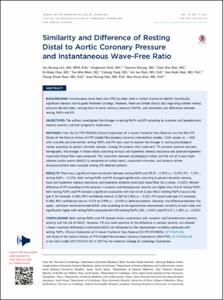KUMEL Repository
1. Journal Papers (연구논문)
1. School of Medicine (의과대학)
Dept. of Internal Medicine (내과학)
Similarity and Difference of Resting Distal to Aortic Coronary Pressure and Instantaneous Wave-Free Ratio
- Affiliated Author(s)
- 남창욱
- Alternative Author(s)
- Nam, Chang Wook
- Journal Title
- Journal of American College of Cardiology
- ISSN
- 0735-1097
- Issued Date
- 2017
- Keyword
- coronary artery disease; discordance; fractional flow reserve; instantaneous wave-free ratio; ischemia; prognosis; resting Pd/Pa
- Abstract
- BACKGROUND:
Instantaneous wave-free ratio (iFR) has been used in clinical practice to identify functionally significant stenosis and to guide treatment strategy. However, there are limited clinical data regarding another resting pressure-derived index, resting distal to aortic coronary pressure (Pd/Pa), and similarities and differences between resting Pd/Pa and iFR.
OBJECTIVES:
The authors investigated the changes in resting Pd/Pa and iFR according to anatomic and hemodynamic stenosis severity and their prognostic implications.
METHODS:
From the 3V FFR-FRIENDS (Clinical Implication of 3-vessel Fractional Flow Reserve) and the IRIS-FFR (Study of the Natural History of FFR Guided Percutaneous Coronary Intervention) studies, 1,024 vessels (n = 435) with available pre-intervention resting Pd/Pa and iFR were used to explore the changes in resting physiological indices according to percent diameter stenosis. Among 115 patients who underwent 13N-ammonia positron emission tomography, the changes in those indices according to basal and hyperemic stenosis resistance and absolute hyperemic myocardial blood flow were compared. The association between physiological indices and the risk of 2-year major adverse cardiac events (MACE) (a composite of cardiac death, myocardial infarction, and ischemia-driven revascularization) were analyzed among 375 deferred patients.
RESULTS:
There was a significant linear correlation between resting Pd/Pa and iFR (R = 0.970; p < 0.001, iFR = 1.370 × resting Pd/Pa - 0.370). Both resting Pd/Pa and iFR changed significantly according to percent diameter stenosis, basal and hyperemic stenosis resistance, and hyperemic absolute myocardial blood flow (all p values <0.001). Percent difference of iFR according to the increase in anatomic and hemodynamic severity was higher than that of resting Pd/Pa. Both resting Pd/Pa and iFR showed a significant association with the risk of 2-year MACE (resting Pd/Pa hazard ratio [per 0.10 increase]: 0.480; 95% confidence interval: 0.250 to 0.923; p = 0.027; iFR hazard ratio [per 0.1 increase]: 0.586; 95% confidence interval: 0.373 to 0.919; p = 0.020) in deferred patients. However, the difference between the upper- and lower-bound estimated MACE rates according to the approximate measurement variability of each index was significantly higher with resting Pd/Pa compared with iFR (resting Pd/Pa 3.85 ± 4.00% and iFR 3.27 ± 3.39%; p < 0.001).
CONCLUSIONS:
Both resting Pd/Pa and iFR showed similar associations with anatomic and hemodynamic stenosis severity and the risk of MACE. However, iFR was more sensitive to the difference in stenosis severity and showed a lower maximum difference in estimated MACE risk influenced by the measurement variability compared with resting Pd/Pa.
- Department
- Dept. of Internal Medicine (내과학)
- Publisher
- School of Medicine (의과대학)
- Citation
- Yaliang Tong et al. (2017). Similarity and Difference of Resting Distal to Aortic Coronary Pressure and Instantaneous Wave-Free Ratio. Journal of American College of Cardiology, 70(17), 2114–2123. doi: 10.1016/j.jacc.2017.09.007
- Type
- Article
- ISSN
- 0735-1097
- Appears in Collections:
- 1. School of Medicine (의과대학) > Dept. of Internal Medicine (내과학)
- 파일 목록
-
-
Download
 oak-2018-1016.pdf
기타 데이터 / 754.95 kB / Adobe PDF
oak-2018-1016.pdf
기타 데이터 / 754.95 kB / Adobe PDF
-
Items in Repository are protected by copyright, with all rights reserved, unless otherwise indicated.